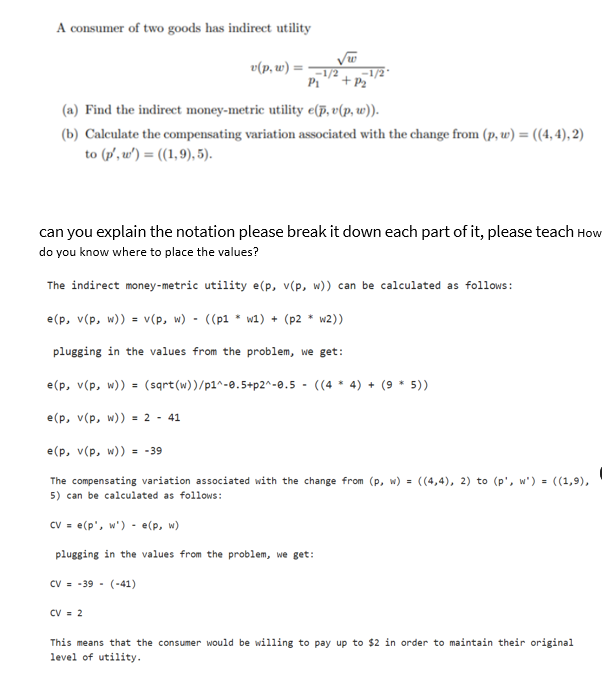A consumer of two goods has indirect utility (a) Find the indirect money-metric utility e(p, v(p, w)). (b) Calculate the compensating variation associated with the change from (p, w) = ((4,4), 2) to (p', u') = ((1,9), 5). v(p, w) = -1/2 P₁ + P₂ can you explain the notation please break it down each part of it, please teach Ho do you know where to place the values? The indirect money-metric utility e(p, v(p, w)) can be calculated as follows: e(p, v(p, w)) = v(p, w) - ((p1 * w1) + (p2 * w2)) plugging in the values from the problem, we get: e(p, v(p, w)) = (sqrt(w))/p1^-8.5+p2^-0.5 - ((44) + (9 * 5)) e(p, v(p, w)) = 2 - 41 e(p, v(p, w)) = -39 The compensating variation associated with the change from (p, w) = ((4,4), 2) to (p', w') = ((1,9), 5) can be calculated as follows: CV = e(p', w')- e(p, w) plugging in the values from the problem, we get: CV = -39 - (-41) CV = 2 This means that the consumer would be willing to pay up to $2 in order to maintain their original level of utility.
A consumer of two goods has indirect utility (a) Find the indirect money-metric utility e(p, v(p, w)). (b) Calculate the compensating variation associated with the change from (p, w) = ((4,4), 2) to (p', u') = ((1,9), 5). v(p, w) = -1/2 P₁ + P₂ can you explain the notation please break it down each part of it, please teach Ho do you know where to place the values? The indirect money-metric utility e(p, v(p, w)) can be calculated as follows: e(p, v(p, w)) = v(p, w) - ((p1 * w1) + (p2 * w2)) plugging in the values from the problem, we get: e(p, v(p, w)) = (sqrt(w))/p1^-8.5+p2^-0.5 - ((44) + (9 * 5)) e(p, v(p, w)) = 2 - 41 e(p, v(p, w)) = -39 The compensating variation associated with the change from (p, w) = ((4,4), 2) to (p', w') = ((1,9), 5) can be calculated as follows: CV = e(p', w')- e(p, w) plugging in the values from the problem, we get: CV = -39 - (-41) CV = 2 This means that the consumer would be willing to pay up to $2 in order to maintain their original level of utility.
Algebra & Trigonometry with Analytic Geometry
13th Edition
ISBN:9781133382119
Author:Swokowski
Publisher:Swokowski
Chapter9: Systems Of Equations And Inequalities
Section: Chapter Questions
Problem 39RE
Related questions
Question
how to know what are the price to uses ?
p w =(( ,), ,) what are the numbers in the brackets p1?
please resolve clearly

Transcribed Image Text:A consum
sumer of two goods has indirect utility
v(p, w) =
√w
-1/2
P₁ + P₂
(a) Find the indirect money-metric utility e(p, v(p, w)).
(b) Calculate the compensating variation associated with the change from (p, w) = ((4,4), 2)
to (p', w')= ((1,9), 5).
can you explain the notation please break it down each part of it, please teach How
do you know where to place the values?
The indirect money-metric utility e(p, v(p, w)) can be calculated as follows:
e(p, v(p, w)) = v(p, w) - ((p1* w1) + (p2 * w2))
plugging in the values from the problem, we get:
e(p, v(p, w)) = (sqrt(w))/p1^-0.5+p2^-0.5- ((44) + (9 * 5))
e(p, v(p, w)) = 2 - 41
CV = 2
e(p, v(p, w)) = -39
The compensating variation associated with the change from (p, w) = ((4,4), 2) to (p', w')= ((1,9),
5) can be calculated as follows:
CV = e(p', w')- e(p, w)
plugging in the values from the problem, we get:
CV-39 (-41)
This means that the consu would be willing to pay up to $2 in order to maintain their original
level of utility.
Expert Solution
This question has been solved!
Explore an expertly crafted, step-by-step solution for a thorough understanding of key concepts.
Step by step
Solved in 2 steps with 2 images

Recommended textbooks for you

Algebra & Trigonometry with Analytic Geometry
Algebra
ISBN:
9781133382119
Author:
Swokowski
Publisher:
Cengage

Algebra & Trigonometry with Analytic Geometry
Algebra
ISBN:
9781133382119
Author:
Swokowski
Publisher:
Cengage